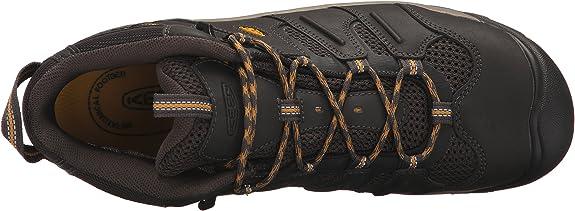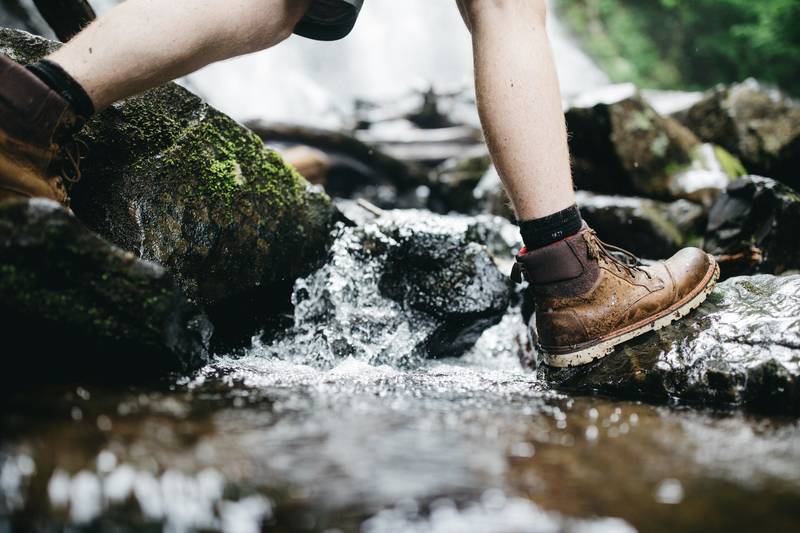The steel toe boots are an enticing option for a hiking trip. The steel toe box promises protection to your dorsum and toe against various hazards. These shoes are commonly used by workers who risk foot injury from falling or rolling objects, punctures, or excessively slippery or uneven surfaces.
The steel toe boots support an aluminum, steel or composite toe box that maximizes space mobility and decreases the risk of injury.
A steel toe box in your shoes can take you a long way on hiking trails that are slippery, have sleet, or risk falling rocks. This article can help you decide if taking your work shoes on a hiking trip is a good idea.
What Are Steel Toe Boots Made For?
Steel toe boots are protective gear for workers requiring maximum traction and protection. Therefore, they are usually made from heavy-duty steel with durable leather(often) to provide advanced level foot protection.
The steel toe box shields the dorsum and toes against large amounts of pressure, objects that could pierce the boot and give puncture wounds.

The steel toe box provides a waterproof, spacious room for your forefoot to achieve maximum mobility during damp conditions.
While you work a slippery, inclined space that is given to landslides, rockfalls or avalanches, your feet are safe from straining under pressure. The bulk of your steel-toe boots keeps you steady and increases your stability by keeping your center of gravity constant.
Benefits of Hiking with Steel Toe Boots
Wearing a steel-toe structure boot for hiking is a good idea for tough terrains that require a lot of pressure resistance from your ankles and a consistent weight distribution for long hauls. Such a boot would give you some benefits that are absent in a standard hiking boot.
Increased Foot Protection
The most basic function of a steel-toe box is protection. The toe box is often made from steel, aluminum, or composite materials that retain the pressure put on them from above.
The toe box reacts by absorbing the shock and shielding your phalanges and connective tissues from injuries.
If you have decided on a rocky trail that is given to rockfall and your trail is mostly just scree, a steel toe boot will resist piercing and jabbing rocks that might puncture your shoe and cause open wounds.
Enhanced Stability and Support
If you have decided on a winter hike that will give you snow and ice, a steel-toe boot will provide you with the structural protection you need for the haulage.
The steel toe boot usually comes with a lug sole that evenly distributes your body weight on the most slippery of surfaces and decreases the chances of sliding and slipping.
Since a steel toe boot is bulky, it provides a large surface area to balance your center of gravity, which is a great feature to have on an inclined winter terrain.
Steel toe boots feature an anatomically correct design to brace your foot against the pressure exerted from keeping your balance on slippery surfaces, saving you from sprains and ligament lesions.
Durability and Longevity
The steel in the toe box preserves the shoe’s shape. It retains its symmetrical correctness, resisting cracks and splitting around the forefoot area.
To add to its longevity, the steel toe boot can endure compression of 2500 pounds, giving you a shoe that will outlast most others under the same circumstances.
Hence, the steel toe boot is your best option for all-around work, both as a worker job and short and rough hiking.
Cons of Hiking with Steel Toe Boots
While the steel-toe boots support features to put the most expensive hiking boot to shame, it is protective gear in the end and isn’t strictly designed for hiking and trekking.
Lack of Flexibility and Comfort
A steel toe box has the structural strength to withstand crushing pressures, but it also lacks the flexibility to mold itself according to the needs of your feet during hiking.
The toe box is a protective armor around your forefoot. It neither stretches nor shrinks like armor to keep you maneuvering around a tricky trail.
Most steel-toe boots come with either no support for the sole of your foot or a very lumpy, puffy cushioning, which provides no room for movement within the shoe.
So, steel-toe boots for a hiking trail that might need agile footwork will not be a good idea.
Reduced Breathability
If you have decided to bring your steel toe boots to a wet trekking trail, you might have to reconsider your options.
The steel toe box has a significantly reduced breathability compared to hiking boots, which have meshing to wick away sweat and quickly dry out.
The steel toe box doesn’t feature a porous surface that results in sweat pooling within the shoe and retains the moisture that enters the shoes from outside.
Bulky
The steel toe boots will be a nightmare for a lightweight backpacker since each boot weighs between 4 and 5 lbs. To add to their bulk, such boots come with lug soles, often in a wedge style and weighing a person down.
On a hiking trip where energy conservation is necessary to haul yourself up and forward, the bulk of your footwear can seriously halt your progress by tiring your feet out sooner and making you stop for rest frequently.
Top Steel Toe Boots for Hiking
If you are interested in hiking in steel-toe boots, here are the best steel-toe boots for hiking. Not all steel toes are good options for hiking due to their construction, but some provide a better mix of values for hiking and other outdoor activities in addition to work boots features.
CAT Threshold Waterproof Steel Toe Boot: The CAT Threshold Waterproof Steel Toe Boot is a highly durable, reliable, stylish-looking boot suitable for work and hiking.

KEEN Utility Lansing Mid Steel Toe Boot: This is another good pair of steel-toe boots that you can wear for short and rough hiking.
This looks less stylish than the CAT Threshold Boot, so if you want style and durability, you may opt for the CAT boot; otherwise, KEEN also does a decent job.
Tips for Hiking with Steel Toe Boots
If your leg muscles are trained to carry the bulk of steel-toe boots, chances are that you will hiking in them easily. However, for a newbie, a few tricks can help with the choice.
Proper Fit and Sizing
Hiking with steel-toe boots can be extremely tricky since it needs a little bit more tact to keep you balanced on an inclined surface.
However, a good fit on your steel toe boot can take you a long way. While testing a pair, your toes should have no space left within the toe box and if you fit your index finger in the heel cap, it should neither be too tight nor too loose.
A good fit will prevent blisters and sores and keep you from sliding within the shoe while you climb a slope.
Break-in Period
The steel-toe shoes require a longer break-in period as compared to other hiking shoes. So, if you have decided to sport steel-toe shoes, you need to spend at least a week on breaking it in.
Wearing the shoe on walks and easy trekking trails can help you access its fit and get your feet acclimated to its structure.
Wear Moisture-Wicking Socks
The decreased breathability of steel-toe shoes caused by the toe box can lead to many issues. Be it skin irritation, sweat-caused slipping and sores, or just a very wet shoe that won’t dry out, your only hope is adding moisture-wicking socks.
The hiking socks are made of Marino wool, which is hypoallergenic and extremely breathable. It helps to evaporate the moisture from your foot without letting it pool within your shoe.
Insoles for Added Comfort
To compensate for the lack of support, you can add an insole to your steel-toe boots for hiking. Insoles help by supporting your feet in case of a wrong foot plant.
While your feet carry the steel toe shoe’s weight, the insole provides orthotic support to your ligaments to compensate for the weight.
How to Choose Steel Toe Boots for Hiking
There are various steel-toe boots that can be customized to your hiking needs. However, a steel-toe boot is mostly a good idea on a tough trail.
For Tough Terrains
If you are on a glacier hike, you will need added traction. A steel-toe boot with lug soles is just what you need. It will provide your phalanges insulation from the cold and the indented sole will give you a stronger grip.
This shoe will keep you from slipping and sliding on sheets of ice and keep you balanced without exerting a lot of pressure on your ankles.
The Weather Conditions
If your trekking trail has dry, hot weather, you might have to pass on the steel-toe shoe. A steel toe box within a shoe provides insulation, which also includes trapping the heat within your shoe.
In the same way, a moisture-laden trail will prove detrimental to your hike since your shoe will trap the water inside your shoe and take a long period to dry.
Thus, you can choose a shoe with a composite material for your toe box. You can explore your options in terms of breathability, cuffs, and even a different sole.
Our Verdict: Can You Hike in Steel Toe Boots?
In short, you cannot hike in steel-toe boots for long hikes due to their heavy and rigid construction, resulting in the lack of flexibility and breathability that proper hiking boots provide. You may use them for short hikes, but a pair of hiking boots will serve you better if a trail requires elaborate and synchronized footwork.
